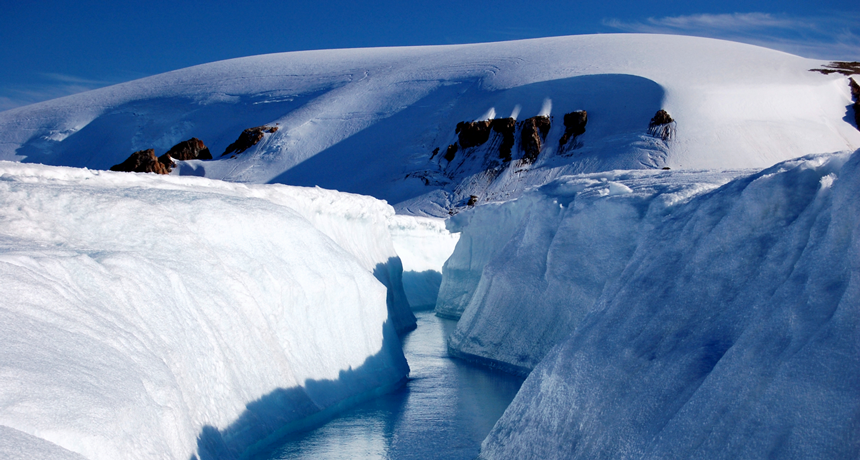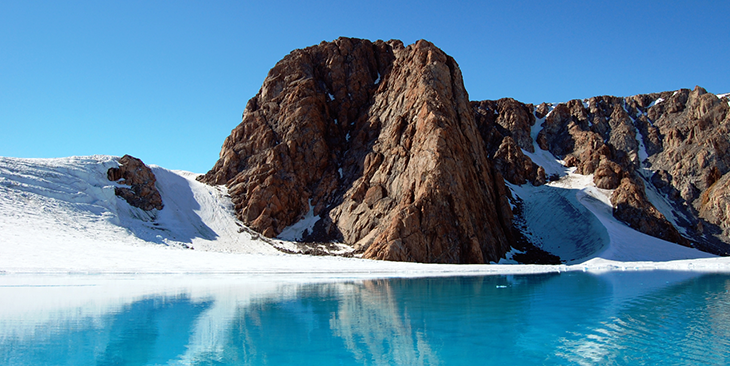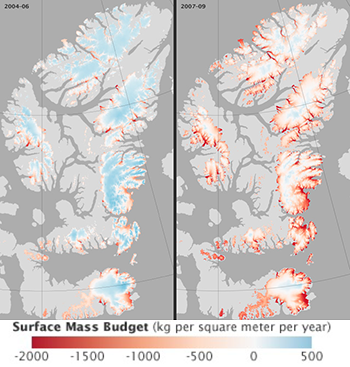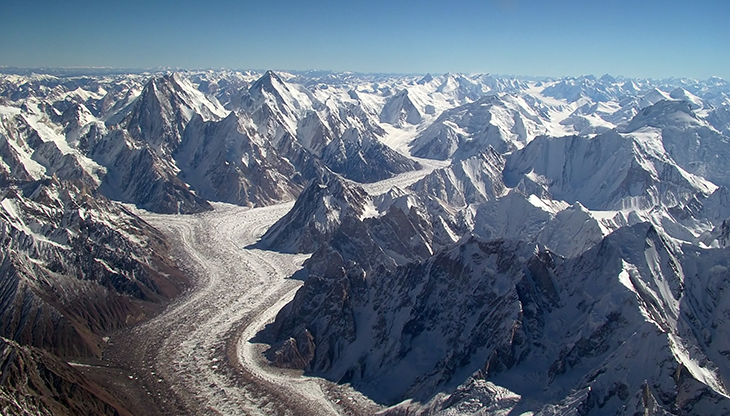Climate change cripples planet’s glaciers and ice caps
Ice in the world’s Arctic and on mountains is thinning, which could pose a threat to people

Warm summers are melting large amounts of snow on the Devon Ice Cap, in the Canadian Arctic. As this melt water gathers into rivers, it carves deep channels in the ice, like the one shown here.
A. Gardner/NASA/JPL-Caltech
By Douglas Fox
Martin Sharp vividly recalls his first slush flow. He spent that June, in 2007, camping on the Devon Ice Cap. This gently curving dome of ice is 140 kilometers (87 miles) across and rises to a height of 1,900 meters (6,200 feet). It sits atop an island in the Canadian high Arctic.
Sharp was riding a snowmobile when he heard a roar. It sounded like the rumble of a subway train. The entire snow slope in front of him was moving: A slow-motion river of waterlogged slush was slurping down the mountainside. A spate of hot, sunny days had melted so much snow that the slope could no longer support itself.
Slush flows didn’t used to happen here. The summers weren’t warm enough, notes this glaciologist at the University of Alberta in Canada. But by the time he saw this one in 2007, he had been hearing about them more and more. In one memorable case, a lake of melt water sitting on top an ice cap suddenly drained. This sent a flood of water, slush and ice rampaging 10 kilometers (6 miles) down a valley. It nearly wiped out a camp where scientists had been staying.

For Sharp, it prompted a decision. He and his colleagues had visited Devon Ice Cap nearly every summer for the last few years. Going forward, they would now come in April or May, when the days were still cool enough to avoid such dangers. “The world has changed,” he says.
Devon is one of thousands of glacial ice masses that dot the world. Some are narrow streams of ice, called glaciers. These ooze down mountain canyons. Others, like Devon, are broad, blobby ice caps that cover entire islands, spreading outward at the edges.
These icy areas are tiny compared to the world’s three great ice sheets, which cover Greenland, and East and West Antarctica. Altogether, these smaller icy areas hold only a hundredth of the world’s ice. But because they occupy parts of the Earth that are warmer than the ice sheets, they are melting much more quickly. For now, they also are a major source of sea-level rise. Collectively, they are losing some 230 cubic kilometers (55 cubic miles) of ice per year. Dump all of that ice into one big pile, and it could form its own mountain range.
Slithering winds
It started when a belt of strong winds shifted that year. Called the polar jet stream, it bent northward like a slithering snake. Its winds carried warm air from the Atlantic Ocean up along the west side of Greenland, into the islands of Arctic Canada.

Alex Gardner was a PhD student at the University of Alberta during the late 2000s. He worked with Sharp. He used a satellite to measure how the glaciers and ice caps of Arctic Canada were changing.
Called IceSat, it carried an instrument called a laser altimeter. As the satellite orbited, it shined a laser beam directly down onto the Earth. By measuring exactly how long the beam took to bounce off Earth’s surface and return, IceSat could measure the precise height of the terrain it was passing over.
IceSat made hundreds of passes over Canada’s glaciers and ice caps. Its data showed Gardner that the ice had begun thinning — and quickly.
From 2004 to 2006, these glaciers and ice caps were losing around 30 billion tons of ice per year. Over time, Gardner found, the rate of ice loss was speeding up. Between 2007 and 2009, for instance, these same glaciers were losing roughly 90 billion tons of ice per year.
By comparing the summer temperatures to the amount of ice lost each year, Gardner discovered a staggering fact. For every 1 degree Celsius (1.8 degree Fahrenheit) of added summer warming, the region was losing and extra 64 billion tons of ice per year. That showed this region had become “incredibly sensitive to a small change in temperature,” he says. He finished his PhD in 2010 and is now continuing this work at the Jet Propulsion Laboratory. It’s at the California Institute of Technology in Pasadena.
The Arctic is warming several times more quickly than the world as a whole. And Gardner’s data suggest that as the Canadian high Arctic continues to warm over the next 70 years, its rate of ice loss could easily double or triple.
But not every mountain glacier and ice cap is experiencing a similar rate of warming. This is especially true in the world’s highest mountain ranges, says Gardner: “You have all of these competing weather patterns in high mountain Asia that make it really complex.”
Asia’s water towers
The Karakoram (Kaer-uh-KOR-am) Range spans the borders of Pakistan, India and western China. It is home to hundreds of glaciers and the world’s second-highest mountain: K2. Its peak reaches up 8,611 meters (28,251 feet). Despite rising temperatures and rapid melting, Karakoram’s glaciers don’t seem to be shrinking. Gardner suspects that higher temperatures may be evaporating more water and sending more clouds over the mountains. These increased clouds are dropping more snow on the glaciers. And this could compensate for the effects of local melting — at least for now.
But mountains farther north, the Tien Shan of western China, have been losing ice quickly. Between 1961 and 2012, their glaciers collectively lost a sixth of their area — and one-fourth of their total ice!
These glaciers aren’t especially big. So even if they vanished, they’d contribute little to sea level rise. “But they play quite an important role” for the local people, says Gardner. The Tien Shan are one example of what scientists call central Asia’s “water towers.”

Even during dry seasons, these glaciers feed rivers. Millions of people across the region depend on those rivers to irrigate their crops when rain isn’t falling.
Though very important to downstream communities, such small mountain glaciers are, in some ways, harder to monitor than the vast ice sheets of Greenland and Antarctica. Many of the satellites that measure changes in the ice sheets don’t work well on small glaciers. Gardner relied on IceSat to keep track of these glaciers. Its narrow laser beam was perfect for measuring the height of small areas of ice. Alas, in 2009 the satellite stopped working.
The last few years have been challenging. Without that satellite’s eyes in the sky, says Gardner, “We’ve been a little bit blind lately.”
But that should change, and soon. On September 15, 2018, NASA launched a new satellite into space. Known as IceSat-2, it will make even more detailed measurements than its predecessor. Once enough measurements are taken, within a few months from now, says Gardner, it “is going to provide us a desperately needed update.”







